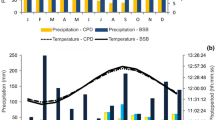Abstract
Andropogon virginicus L. (broomsedge) is a perennial bunchgrass of temperate origin which was introduced to the Hawaiian Islands early in the 20th Century. Since its introduction broomsedge has become the dominant species of savanna vegetation on the windward sides of Oahu and Hawaii (the Big Island). Despite its ecological success, the phenology of broomsedge-especially the timing of its periods of active growth in the summer and dormancy (or semi-rest) in the winter-is not synchronized with the summer-dry, winter-wet moisture seasonality of its range in Hawaii. Rather, this species responds to a shortening-daylength cue by flowering in late autumn, and the onset of dormancy and the progression of subsequent phenophases seems to be mostly under endogenous control following the flowering response. The lack of synchronization between the onset of active growth by broomsedge and the onset of the rainy season does not conform to the specific assumption that the ecological dominance of the perennial bunchgrass life-form in savanna vegetation results from a coupling of phenological strategy to moisture seasonality. It also brings into question the more general assumption that a perfect coupling of phenology to the prevailing climatic conditions is a prerequisite for ecological success.
Similar content being viewed by others
References
Allard, H. A. & Garner, W. W. 1940. Further observations on the response of various species of plants to length of day. U.S. Dept. Agr., Tech. Bull # 727, pp. 1–64.
Boaler S. B. 1966. Ecology of a Miombo site, Lupa North Forest Reserve, Tanzania. II. Plant communities and seasonal variation in the vegetation. J. Ecol. 54: 465–479.
Bryan, L. W. 1977. Letter to editor. Hawn. Bot. Soc. News-letter, No. 16(3/4): 63.
Evans L. T., 1980. The natural history of crop yield. Am. Sci. 68: 388–397.
French N. & Sauer R. H. 1974. Phenological studies and modeling in grasslands. In: H. Lieth, (ed.). Phenology and seasonality modeling. Springer-Verlag, New York.
Golley F. B. 1965. Structure and function of an old field broomsedge community. Ecol. Monogr. 35: 113–131.
Harper J. L. 1977. Population biology of plants. Academic Press, London.
Hopkins B. 1968. Vegetation of the Olokemeji Forest Reserve, Nigeria. V. The vegetation on the savanna site with special reference to its seasonal changes. J. Ecol. 56: 97–115.
Kartawinata K. & Mueller-Dombois D. 1972. Phytosociology and ecology of the natural dry-grass communities on Oahu, Hawaii. Reinwardtia 8: 369–494.
Lieth H. 1974. Phenology and seasonality modeling. Springer-Verlag, New York.
Monasterio M. & Sarmiento G. 1976. Phenological strategies of plant species in the tropical savanna and the semideciduous forest of the Venezuelan Llanos. J. Biogeogr. 3: 325–356.
Mueller-Dombois D. 1973. A non-adapted vegetation interferes with water removal in a tropical rain forest area in Hawaii. Trop. Ecol. 14: 1–18.
Mueller-Dombois D. & Ellenberg H. 1974. Aims and methods of vegetation ecology. John Wiley and Sons, New York.
Mueller-Dombois, D. & Fosberg, F. R. 1974. Vegetation map of Hawaii Volcanoes National Park. Cooperative National Park Resources Studies Unit. UH/NPS Unit Tech. Report No. 4.
Norman M. J. T. 1963. The pattern of dry matter and nutrient content changes in native pastures at Katherine N.T. Aust. J. Exp. Agr. Anim. Husb. 3: 119–124.
Podolsky A. S. 1984. New phenology. John Wiley and Sons, New York. 504 pp.
Rathcke B. J. & Lacey E. P. 1985. Phenological patterns of terrestrial plants. Ann. Rev. Ecol. Syst. 16: 179–214.
Sarmiento G. 1984. The ecology of neotropical savannas. Harvard University Press, Cambridge, Massachusetts.
Sarmiento G. & Monasterio M. 1983. Life forms and phenology. pp. 79–108 in Ecosystems of the world, v. 13: Tropical savannas, F. Bourliere (ed.). Elsevier Scientific Bublishing Co., Amsterdam.
Silva J. F. & Ataroff M. 1985. Phenology, seed crop and germination of coexisting grass species from a tropical savanna in Western Venezuela. Acta Ecol./Ecol. Plant. 6(20): 41–51.
Smithsonian Meterological Tables. 1966. Sixth edition. Prepared by J. R. List. Smithsonian Institution, Washington, D.C.
Sorenson, J. C. 1980. Phenology ofAndropogon virginicus in Hawaii. M.S. Thesis, University of Hawaii.
Taliaferro, W. J. 1959. Rainfall of the Hawaiian Islands. Hawaii Water Authority. 394 pp.
Walter H., Harnickell E. & Mueller-Dombois D. 1975. Climate-diagram maps of the individual continents and the ecological climate regions of the earth. Springer-Verlag, New York. 36 pp. + manual + 9 maps.
Yadava P. S. & Singh J. S. 1977. Progress in ecology. Vol. II: Grassland vegetation. Today and Tomorrow's Printers and Publishers. New Delhi.
Author information
Authors and Affiliations
Rights and permissions
About this article
Cite this article
Sorenson, J.C. On the relationship of phenological strategy to ecological success: the case of broomsedge in Hawaii. Vegetatio 95, 137–147 (1991). https://doi.org/10.1007/BF00045212
Accepted:
Issue Date:
DOI: https://doi.org/10.1007/BF00045212




